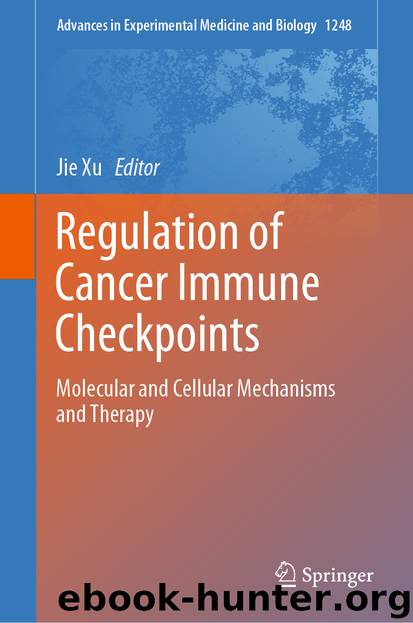Regulation of Cancer Immune Checkpoints by Jie Xu

Author:Jie Xu
Language: eng
Format: epub
ISBN: 9789811532665
Publisher: Springer Singapore
13.7 CD226/CD112/CD155/Tigit
CD226, belonging to the immunoglobulin superfamily, is a I transmembrane glycoprotein widely expressed in various types of immune cells (Sanchez-Correa 2019). CD226 molecules are widely expressed in various immune cells, such as NK cells, T lymphocytes, and monocytes/platelets (Sanchez-Correa 2019). Various cytokines, including IL-1α, IL-1β, IL-2, IL-3, TNF-α and IL-15 (Hromadnikova et al. 2013; Fujii et al. 2018; Xu and Jin 2010), can upregulate the expression of CD226, and super-antigen SEA and SEB (Zhang et al. 2006) also have the same effect on CD226. While TGF-β downregulates the expression CD226 expression (Jin et al. 1989). The ligands for CD226 molecular are mainly PVR/CD155 and PRR2/nectin-2/CD112 which are both highly located on the surface of various tumor cells (Bottino et al. 2003; Pende et al. 2006). CD155 is not only a polio-specific receptor and but also highly expressed in tumor tissues (Gao et al. 2017). CD112 is the receptor of herpes simplex virus, which is largely expressed in CD34+ hematopoietic progenitor cells and CD33+CD14+ myelo-mononuclear cell line while limitedly expressed in megakaryocytes (Pende et al. 2006). The immunosuppressive molecule TIGIT can bind to CD112 and CD155 in competition with CD226 (Solomon and Garrido-Laguna 2018; Shibuya et al. 2003). The extracellular segment of TIGIT contains an immunoglobulin (Ig) V-like domain, and the intracellular segment contains an immunoreceptor tyrosine-based inhibitory motif (ITIM) which can mediate negative regulatory signal transduction after binding to the receptor (Dougall et al. 2017; Manes and Pober 2011). TIGIT is preferentially expressed in regulatory T cells (Treg), activated and memorized T cells, and has been shown to promote the secretion of IL-10, thereby modulating DCs and effector T cells (Stein et al. 2017). CD226 promotes the adhesion of NK cells to tumor cells by binding to receptor immunoglobulin-like structure, enhancing T cells cytotoxic activity towards tumor cells (Martinet and Smyth 2015).
Taken together, the activating receptor CD226 can be detected on several immune cell surface including NK cells, monocytes, and different T lymphocyte subsets (CD4+ and CD8+, NKT and γδ T cells) and CD226 interacts with both Nectin2 and PVR (Tahara-Hanaoka et al. 2005; Seth et al. 2009). CD226 on NK cell and cytotoxic CD8+T lymphocytes (CTL) surface contributes to the recognition and killing of transformed and virus-infected cells. The expression of both Nectin2 and CD155 is upregulated on tumor and virus-infected cells, leading to an increased CD226-mediated recognition. Therefore, investigation on the molecular regulation mechanisms of CD226 must be carried on to potentiate new approach for anti-tumor and anti-viral immune responses.
However, little is known about the posttranslational modification related regulation of the above four immune checkpoints except some findings as follows. It is established that posttranslational modification of CD155, namely SUMOylation, regulates its intracellular localization (Zitti et al. 2017). In addition, it is reported recently that CD112 is ubiquitinated, which is responsible for its proteasomal degradation and protein retention in intracellular organelles (Molfetta et al. 2019) (Fig. 13.10). Inhibiting ubiquitination of CD112 upregulates CD112 expression on tumor cell surface, resulting in increased susceptibility of tumor cells to NK-mediated cytolysis (Molfetta et al.
Download
This site does not store any files on its server. We only index and link to content provided by other sites. Please contact the content providers to delete copyright contents if any and email us, we'll remove relevant links or contents immediately.
| Administration & Medicine Economics | Allied Health Professions |
| Basic Sciences | Dentistry |
| History | Medical Informatics |
| Medicine | Nursing |
| Pharmacology | Psychology |
| Research | Veterinary Medicine |
Tuesdays with Morrie by Mitch Albom(4691)
Yoga Anatomy by Kaminoff Leslie(4306)
Science and Development of Muscle Hypertrophy by Brad Schoenfeld(4089)
Bodyweight Strength Training: 12 Weeks to Build Muscle and Burn Fat by Jay Cardiello(3915)
Introduction to Kinesiology by Shirl J. Hoffman(3725)
How Music Works by David Byrne(3187)
Sapiens and Homo Deus by Yuval Noah Harari(2987)
The Plant Paradox by Dr. Steven R. Gundry M.D(2547)
Churchill by Paul Johnson(2506)
Insomniac City by Bill Hayes(2498)
Coroner's Journal by Louis Cataldie(2432)
Hashimoto's Protocol by Izabella Wentz PharmD(2331)
The Chimp Paradox by Peters Dr Steve(2297)
The Universe Inside You by Brian Clegg(2097)
Don't Look Behind You by Lois Duncan(2080)
The Immune System Recovery Plan by Susan Blum(2028)
The Hot Zone by Richard Preston(1983)
Endure by Alex Hutchinson(1964)
Woman: An Intimate Geography by Natalie Angier(1882)
